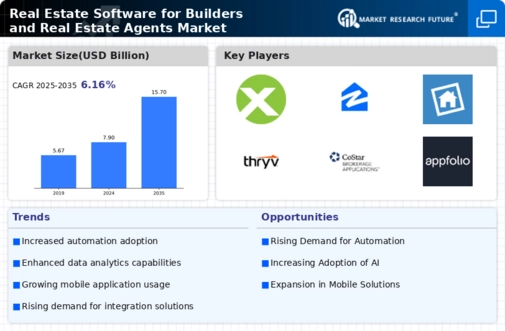Market Growth Projections
The Global Real Estate Software for Builders and Real Estate Agents Market Industry is projected to experience substantial growth over the coming years. With a market value of 7.9 USD Billion in 2024, it is anticipated to reach 15.7 USD Billion by 2035, reflecting a robust CAGR of 6.42% from 2025 to 2035. This growth trajectory indicates a strong demand for innovative software solutions that cater to the evolving needs of builders and agents. Factors such as technological advancements, increased automation, and rising consumer expectations are likely to contribute to this positive outlook, suggesting a dynamic future for the industry.
Technological Advancements
The Global Real Estate Software for Builders and Real Estate Agents Market Industry is experiencing rapid technological advancements, particularly in artificial intelligence and machine learning. These technologies enhance property management, streamline transactions, and improve customer relationship management. For instance, AI-driven analytics can predict market trends, enabling builders and agents to make informed decisions. As of 2024, the market is valued at 7.9 USD Billion, reflecting a growing reliance on technology to optimize operations. This trend is likely to continue, as the integration of advanced technologies may lead to increased efficiency and reduced operational costs, further driving market growth.
Rising Consumer Expectations
The Global Real Estate Software for Builders and Real Estate Agents Market Industry is significantly influenced by rising consumer expectations. Today's clients demand seamless experiences, personalized services, and instant access to information. As a result, builders and agents are compelled to adopt sophisticated software solutions that cater to these needs. This shift is evident in the growing investment in customer relationship management systems and user-friendly platforms. Meeting these expectations is crucial for retaining clients and gaining referrals, which in turn drives market growth. The industry's evolution towards enhanced customer service is likely to shape future software developments.
Growing Focus on Data Analytics
Data analytics is becoming a cornerstone of the Global Real Estate Software for Builders and Real Estate Agents Market Industry. Real estate professionals are leveraging data to gain insights into market dynamics, customer preferences, and investment opportunities. By utilizing analytics tools, builders and agents can make data-driven decisions that enhance their competitive edge. The increasing availability of big data and advanced analytics solutions is likely to propel market growth. As the industry evolves, the ability to harness data effectively may differentiate successful players from their competitors, indicating a shift towards a more analytical approach in real estate.
Increased Demand for Automation
The Global Real Estate Software for Builders and Real Estate Agents Market Industry is witnessing a surge in demand for automation solutions. Builders and agents are increasingly adopting software that automates routine tasks such as lead generation, client communication, and document management. This shift not only enhances productivity but also allows real estate professionals to focus on strategic activities. The market's projected growth from 7.9 USD Billion in 2024 to 15.7 USD Billion by 2035, with a CAGR of 6.42% from 2025 to 2035, underscores the importance of automation in meeting the evolving needs of the industry.
Regulatory Compliance and Security
Regulatory compliance and data security are paramount concerns within the Global Real Estate Software for Builders and Real Estate Agents Market Industry. As regulations surrounding data protection and real estate transactions become more stringent, builders and agents must adopt software that ensures compliance and safeguards sensitive information. This necessity is driving the demand for robust software solutions that incorporate security features and compliance tools. The ongoing evolution of regulations may further influence software development, as industry players seek to mitigate risks associated with non-compliance. Consequently, this focus on security and compliance is likely to shape the future landscape of the market.














